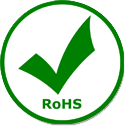RoHS Compliance

What is it?
RoHS is an acronym for the Restriction of Hazardous Substances. The RoHS Directive 2011/65/EU was enacted by the European Union to restrict the use of certain hazardous substances in electrical and electronic equipment (EEE). The directive was put into effect in 2011 in an effort to protect human health and the environmentally sound recovery and disposal of waste EEE. Directive 2015/863/EU added four additional substances to the list.
Which substances are banned?
The directive bans the use of the following ten substances: lead (Pb), mercury (Hg), cadmium (Cd), hexavalent chromium (Cr+6), polybrominated biphenyl (PBB), polybrominated diphenyl ether (PBDE), di(2-ethylhexyl) phthalate (DEHP), butyl benzyl phthalate (BBP), dibutyl phthalate (DBP), and diisobutyl phthalate (DIBP). Visit the Directive for more information on the restricted levels.
Is it mandatory that labels and packaging comply?
The Directive mandates that anything within the end product which can be identified as a homogeneous material (ex. paper, wood, glue, etc) must be tested. As such, if the labels are part of the packaging that will be discarded before use, they don't fall within the scope. However, if the labels are permanently affixed to the product, they may be subject to compliance certification.
Is OnlineLabels compliant?
OnlineLabels offers a wide variety of RoHS3-compliant label materials. View our RoHS3 compliance statement.
Why does this matter to you, the customer?
While the Directive began in Europe, some US states and cities have followed suit. California, for example, is one US state that also bans these substances. We may begin to see additional legislation on the subject in the future in more cities and states as well.
Why does this matter to OnlineLabels?
Many of our customers use our labels for local, national, and international business. We want to make sure we are always meeting or exceeding your needs. If your products must be RoHS3 compliant, we want to help.
In addition, these chemicals are harmful to the environment and pollute landfills. We care about our planet and want to make sure it's healthy for future generations. We also want to protect employees during the manufacturing and recycling operations, our customers during their application processes, and the end user during use.
Download our RoHS Compliance Statement* The information listed above is based on documentation released by the US Government, and is current as of April 2019.
